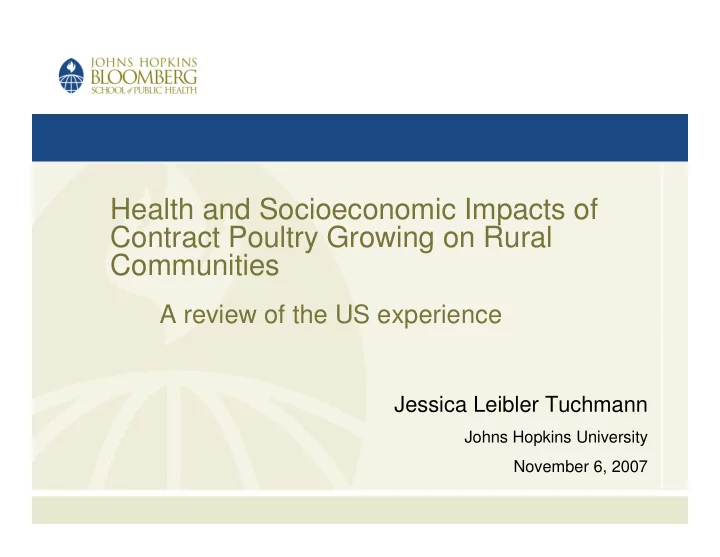

Health and Socioeconomic Impacts of Contract Poultry Growing on Rural Communities A review of the US experience Jessica Leibler Tuchmann Johns Hopkins University November 6, 2007
�������� • Contract poultry growing is central to the industrial model of poultry production and is rapidly expanding in developing nations • Contract growing allows firms to “outsource” the negative byproducts of production • The US experience may provide insight into implications of the global expansion of contract growing
�������������������������������������� �������������������� • 15,000-75,000 chickens per house • 9 billion chickens produced each year • $21 billion industry • Global expansion
���������������� • Firms contract out the raising of chickens from hatchling to market weight to independent farmers (“growers”) • Growers provide: land, labor, facilities, utilities, operating and maintenance costs • Firms retain ownership of birds, provide feed • Growers responsible for waste management, implementation of biosecurity plans
��������������������������� • Start-up costs: more than $600,000 • Contracts – Short term – Integrator may require continual upgrades • Grower payments – Relative to feed conversion ratio of other growers that week
���������!����������������������� ���������� Negative externality: Harmful byproducts or impacts of production (i.e. pollution or health risks) that are borne by groups who do not make production decisions • For contract growing: – Waste disposal – Exposure to zoonotic pathogens – Biosecurity – Socioeconomic decline
"������������������������������ • 14.6 million tons of poultry waste produced annually • Growers bear the costs associated with waste disposal, removal, disposal of dead birds • Public bears costs of environmental contamination Source: http://www.ipm.iastate.edu/ipm/icm/2005/7-25/manure.html
#!����������$������������������ #!������������������%��������������&��� • Infectious pathogens persist in animal manure, confinement houses, surrounding environment – E.g . Campylobacter jejuni, e.coli , avian influenza • Evolution of drug resistant bacteria from antibiotics used in feed at subtherapeutic levels • High density: viral mutation, amplification of AIVs • Occupational, family and community pathways • No health care benefits from the integrator
������������������������������������� ������������ Who pays and who benefits? • Growers assume costs associated with biosecurity measures • Excluded from compensation schemes for flock loss because do not own the birds • Disincentive to report illness and die-offs
������������������������������� ����������� • Contracting associated with economic and social decline in rural communities – 70% of growers in the US earn incomes below the federal poverty line – Decreased municipal tax revenue and property values • Facilities located in poor, minority communities – Equity of burdens vs. benefits • Increased social discord between contract growers and independent farmers
�����������!����������������� ���������������� • Waste management is a key issue – Focus on reducing health and environmental impacts of manure – Waste treatment and regulation are required • Highlight pathogens, as well as nutrients • Available, affordable treatment technology critical • Health care and disease surveillance of growers – Front line population – Encourage prevention, early identification of zoonotic infection
����������#!����������� • Cost sharing arrangement between grower and integrator for implementation of biosecurity plans • Compensation schemes must explicitly include payment to growers in event of flock loss – Recognize shared investment in flock – Encourage early identification and containment of outbreaks • Laws to protect contract growers – Fair contract and negotiation terms
'�����������������&�������� • Dr. Ellen Silbergeld – Johns Hopkins Bloomberg School of Public Health • Dr. Joachim Otte – Pro-Poor Livestock Policy Initiative, FAO Special thanks to: • Jay Graham, Carol Resnick, Rhonda Jackson, and Ruth Faden (Johns Hopkins University) • Jackie Nowell (United Food and Commercial Workers) • Carole Morison (Delmarva Poultry Justice Alliance) • Brother Dave Andrews (National Catholic Rural Life Alliance)
Recommend
More recommend